|
|
When noted Armenian-American
author William Saroyan wrote — in "Antranik of Armenia," "Inhale
and Exhale," 1935 — "The Turk is the brother of the
Armenian and (the manipulative powers) know it," you could tell he
was not your typical hateful extremist Armenian. I haven't made a study of his
views on the genocidal driving force of his people; I don't believe he
generally went out of his way to publicly profess love for the Turks, as that
would have been one sure way to face ostracism. Nevertheless, this page will
feature some clues on how he stood apart from the general Armenian consensus.
|
|
|
| |
Prof. Turkayya Ataov reported in his "What really happened in Geneva"
booklet that the then-twenty-year-old had translated "My Name is Aram," perhaps
the first Turkish translation of a Saroyan work. Ataov wrote:
I had then selected William Saroyan because
he loved the friendship of small, less complicated environments. He rose to great heights,
often producing masterpieces. With no social graces and not wanting any, he preferred the
rough-and-ready. His first short story was published in 1933 and was reprinted in the 1934
Best Short Stories. The Daring Young Man on the Flying Trapaze, which appeared the same
year as title-story of his first volume, was an instant success. In 1939 he suddenly
became a playwright with My Heart’s in the Highlands. He received the Pulitzer Prize for
Drama in 1940 for The Time of Your Life (but declined it). His satirical novel The
Adventures of Wesley Jackson was described as the first anti-war novel of the Second World
War. “Aram” was the name of his own son, but his My Name is Aram was an
autobiographical collection of stories that revolve around the life of a boy in Fresno,
California. All this is certainly known to the Armenian intellectuals as well.
What they may not know equally well, however, is William Saroyan’s visit to Turkey and
its consequences. He came to Turkey in May 1964, visiting Bitlis and the surrounding
areas. He was very well received by the Turks of all levels, the simple folk of Bitlis
embracing him in the outskirts of the town with traditional music and dancing. And Saroyan
did not participate in the April demonstrations when he went back to California.25
Moreover, in a hand-written statement that he left with Turkey’s celebrated journalist,
painter and photographic artist, Fikret Otyam, he stated that he came to “know the
simplicity, hospitality and dignity of the Turkish nation”. (For a photocopy of the
original statement, in Saroyan’s own hand-writing see Annex 2.) It was reported later
that Saroyan’s absence in the April demonstrations in the United States could not go
unnoticed.
|
Annex 2
|
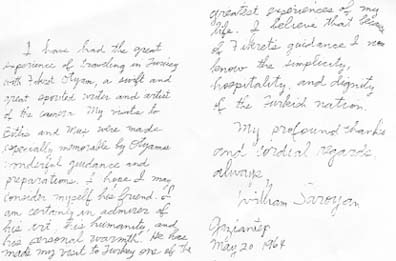
I have had the great experience of traveling
in Turkey with Fikret Otyam, a swift and great spiritied writer and artist of the
camera. My visits to Bitlis and Mus were made especially memorable by Otyam's
wonderful guidance and preparations. I hope I may consider myself his friend. I am
certainly an admirer of his art, his humanity, and his personal warmth. He has made
my visit to Turkey one of the greatest experiences of my life. I believe that
because of Fikret's guidance I now know the simplicity, hospitality and dignity of
the Turkish nation.
My profound thanks and cordial regards,
always.
William Saroyan
Gaziantep
May 20, 1964
|
| Photos of William
Saroyan's 1964 visit to Turkey |
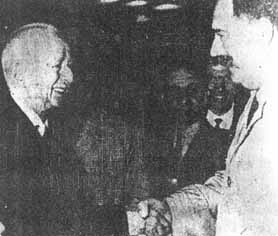 |
|
Saroyan
shaking hands with Turkey's veteran
statesman Ismet Inonu
|
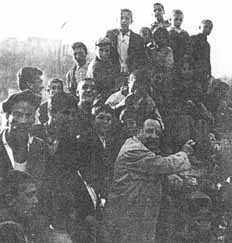 |
|
William
Saroyan with Turkish villagers
|
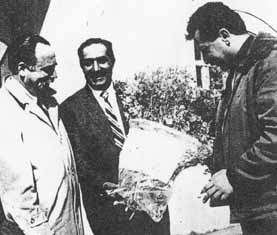 |
|
William
Saroyan, presented flowers on behalf of the
town dwellers
|
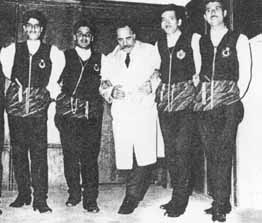 |
|
William
Saroyan, with Turkish folk dancers
|
|
"The real enemy of the
Armenians were the Russians, not the Turks"
Selected excerpts from Yuksel Oktay's writings
|
Greeks invaded Anatolia in 1919 with the hope of
creating their ‘’Greater Hellen Empire’’ and the support of the Western
powers, killed thousands of Turkish civilians and destroyed many villages and towns
along the way, which is well documented. They were defeated by the Turks under the
leadership of Mustafa Kemal who spared the life of the Greek Commander Trikopis and
established good relations with Venizelos, who later became the Prime Minister of
Greece and nominated Mustafa Kemal Ataturk for the Nobel Peace Prize. Turks and
Greeks have been able to create a sense of reconciliation and friendship that
benefits the people of both countries, which the Armenians should heed to.
William Saroyan, the great Armenian-American writer, the son of an Armenian from
Bitlis, wrote about an episode that came closest to the above statement by his Greek
colleague when he said that ‘’The real enemy of the Armenians were the Russians,
not the Turks’’. Saroyan wrote many books, received the Pulitzer Prize for his
book on the second world war "The Human Comedy" and told the story of the
Armenian Tragedy in his short story "Antranik of Armenia."
‘’The war was with the Turks of course. The other enemies were less active
than the Turks, but watchful. When the time came one of these, in the name of love,
not hate, accomplished in no time at all what the Turks, who were more honest, whose
hatred was unconcealed, could not accomplish in hundreds of years. These were the
Russians.’’
Yuksel Oktay, ANATOLIAN RESPONSES TO ARMENIAN ALLEGATIONS
======================================
Review of a book on Antranik of Armenia, ‘’ANTRANIK PASA’’, written
by Antranik Celebyan. Istanbul, 2003. (Translated to Turkish from the original
Armenian version by Mariam Arpi and nairi Arek.) Peri yayinlari, Istanbul, Turkey
April 4, 2004, Istanbul
The first time had I heard about Antranik of Armenia was in a story written by
William Saroyan with the same title in 1935. William Saroyan, the pulitzer price
winner and one of my favorite authors, was born in Fresno California whose
grandparents had immigrated to the area from Bitlis,Turkey in 1905. In his story of
Antranik of Armenia, Saroyan does not present a favorable picture of Antranik after
meeting him following Antranik’s settlement in California, and states in his story
that ‘’the enemy of the Armenians were not the Turks, but the Russians.’’
Antranik was famous for his collaborations with the Russians and killing of Turks
after the Armenian organizations chose the Bulgarian method to gain their
independence, meaning practising terrorism and from time to time, organizing open
revolts where Moslems would be massacred. Several Turkish publications on Antranik
quotes that Antranik was a rebel leader, not a Pasa and he would love to brag about
‘’how many Moslems he had killed in one day.’’
Therefore I was very interested in finding out about, first what the Armenians
thought about Antranik and, second, why they never refer to anything written by
William Saroyan, including Peter Balakian, in his one sided book ‘’The Burning
Tigris’’. The first is a very long story, which I will try to summarize below,
but the answer to the second one is very simple, which the book gives us quite
innocently.
On page 336, this is what Celebiyan quotes from Sarayon: ‘’Soviet Armenia is
our sun, stone, ocean, history, and our unity. The Russian support is a great chance
for us. We can not survive without the support of a strong power. That strong power
is the Soviets. It is the Soviets that give the freedom to the Armenians, help us to
breathe and to show our strength and riches. The Russians are our brothers and
friends. For 50 years we have been enjoying the fruit of this friendship. We are
alive, healthy and happy because, we have a Soviet Armenia. There are no obstacles
for us. Because the Soviets are behind us’’.
And yet, when William Saroyan sees what the Russians are up to, he does not hesitate
to call them the ‘’real enemy of the Armenians’’, as he elaborates in his
story, ‘’Antranik of Armenia’’. When the Turks lost the Turco-Russian war in
the east and the Russians were nearing Istanbul on the west, the Armenians were
[jubilant]. Even the Armenian Patriarch started working with the Russians. However,
as the invading Russian armies left the Ottoman lands after the 1917 Russian
revolution, the Armenians took over and started mass killings which are being
unearthed even today. The Armenians tried to establish a greater Armenia including
the lands from the eastern Anatolia which the book constantly refers to as the
‘’Western Armenia’’. But William Saroyan knew the reality and never
supported the back stabbing of the Turks by the Armenians.
|
| William
Saroyan on the "Genocide" |
The great author wrote an introduction to "I Ask You Ladies and
Gentlemen," a 1945 book that blames Enver Pasha for having exterminated the
Armenians. Saroyan gives no hint of disagreeing. Troublingly, he even refers to Franz Werfel as a legitimate source.
INTRODUCTION
BY WILLIAM SAROYAN
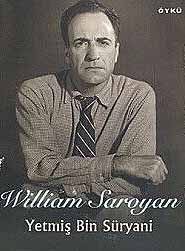 |
|
A
Saroyan book (70,000 Assyrians)
translated into Turkish, taken
from this designer's site;
there
are more. Turkkaya Ataov may have
translated the first Saroyan book
into Turkish (My Name is Aram),
over fifty years ago. |
THIS is a solemn, gentle, civilized book, full
of innocence, comedy, and that kindly power which is the possession of men who are
truly alive and cultured.
Leon Z. Surmelian is one of the many Armenian children of war years who fooled the
enemy and didn’t die. The story of these children is by now well-known to
everyone. Franz Werfel tells part of it in The Forty Days of Musa Dagh, and
Elgin Groseclose tells a little more in Ararat.
Here, however, for the first time is the full story, by one of the children himself.
Their world was destroyed, but not their lives. Many of them are now in Soviet
Armenia, Russia, Persia, Syria, Greece, Canada, Mexico, South America, and America.
Many are dead in the old country, with the world that was destroyed. Their comrades,
who were tougher or luckier, will never forget them. Their enemy was not any
particular nation or any particular people. Their enemy was Evil, as abstract as
Evil might be in any parable. These children were certainly innocent. If they
belonged to any nation, it was to the nation of children. They had wronged no one.
And yet Evil in men sought to destroy them, and as if they were real only in a
fable, rather than in reality itself, these children lived.
Leon Z. Surmelian came out of the old country to America, and proceeded to mend the
wrecked, legend of his life.
This book tells the story of that mending.
It is a story without hate, for hate and death are partners, and this is a story of
life.
I Ask You, Ladies and Gentlemen contains some of the finest writing I have
ever read. The whole book is almost a lyric poem. Surmelian’s style is simple and
unaffected, warm and humorous, and at the same time full of the melancholy of the
civilized and intelligent.
I can’t imagine anybody being disappointed with this book. It is one of the most
beautiful and exciting stories I have ever read. I say this in spite of the fact
that Leon Z. Surmelian is my friend.
I know a great and good book when I see one.
|
| |
Richard Rodriguez ("Pacific News Service" editor)
wrote:
The best advice I ever got as a writer I got from Saroyan in the
preface to his wonderful 1931 collection, "The Daring Young Man on the Flying
Trapeze." I pass it along to you, to any young writer, whatever the age, who might
need the reminder.
Saroyan wrote "The most solid advice for a writer is this, I
think: Try to learn to breathe deeply, really to taste food when you eat, and when you
sleep really to sleep. Try as much as possible to be wholly alive with all your might, and
when you laugh, laugh like hell. And when you get angry, get good and angry. Try to be
alive. You will be dead soon enough."
|
|